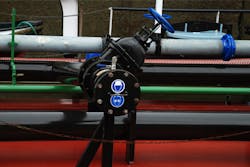The time it takes for people to recognize an error or oversight can be small (think about a hand exposed to fire) or take decades. The consequences of the former are usually learned in a short period of time, often shared with others and hopefully last for a lifetime. The latter often entail subtleties that become apparent serendipitously or when the problem appears again many years later.
Some years ago, a plant used an existing insertion Pitot tube to measure the fume flow to the incinerator. The flow of fumes not only provided cooling to the fume nozzles, but also represented a significant mass flow in the incinerator. Therefore, the fume flow was measured to assure the operator that the fume nozzles were being cooled, and to provide information so the operator could operate the auxiliary air fan when insufficient fumes were available to cool the fume nozzles.
The fume flow measurement was not used for control and the process was straightforward — the fumes or auxiliary air were routed to the fume nozzles — so the existing fume flowmeter measured the total fume flow. It typically measured approximately zero, 30 or 60 percent of full scale to reflect the number of operating blowers.
When the incinerator was upgraded, the fumes were partially used in place of a portion of the combustion air. This change provided superior destruction of wastes in addition to reducing fuel consumption and increasing incineration capacity.
The downside was that the fume piping was more complex and the fume flow to the fume nozzles needed to be continuously maintained and controlled. In addition, the fume flow could replace up to 80 percent of the combustion air and would drop to near zero flow approximately 5 seconds after the fume blowers turned off to either stop production or trip the unit (which could happen at any time).
More next month.
David W. Spitzer is a regular contributor to Flow Control magazine and a principal in Spitzer and Boyes LLC, which offers engineering, seminars, strategic, marketing consulting, distribution consulting and expert witness services for manufacturing and automation companies. Spitzer and Boyes is also the publisher of the Industrial Automation INSIDER. He has more than 40 years of experience and has written more than 10 books and 350 articles about flow measurement, instrumentation and process control.
Spitzer may be reached at 845-623-1830 or via spitzerandboyes.com. Click on the "Products" tab to find his Consumer Guides to various flow and level measurement technologies.


